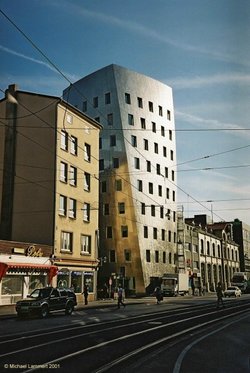Frank Gehry
|
|
Gehry_Pritzker.JPG
Frank Owen Gehry (born Ephraim Goldberg on February 28, 1929) is an architect known for his sculptural approach to building design. He was born in Toronto, Canada, but moved at age 17 to California, where he studied at Los Angeles City College before graduating from the University of Southern California School of Architecture. He then studied city planning at the Harvard Graduate School of Design. He is today a naturalized American citizen and lives in Los Angeles. He is best known for building curvaceous structures, often covered with reflective metal. His most famous work, and the clearest expression of his style, is the Guggenheim Museum in Bilbao, Spain, which is covered in titanium.
Gehry's style is derived from late modernism. The tortured, warped forms of his structures are considered expressions of the deconstructivist (DeCon) school of modernist architecture. The DeCon movement departs from modernism in its de-emphasis of societal goals and functional necessity. Unlike early modernist structures, DeCon structures are not required to reflect specific social ideas (e.g. speed, universality of form), and they do not reflect a belief that form follows function. DeCon, which Gehry has continued to refine, is also known as the Santa Monica school of architecture. This region of the United States has produced the greatest range of experimentation in the field of DeCon design and contains the largest concentration of the structures.
Gehry is considered a modern architectural icon and celebrity. He has appeared in Apple's black and white "Think Different" pictorial ad campaign that associates offbeat but revered figures with Apple's design philosophy. His buildings, including his private residence, have become tourist attractions. Many museums, firms, and cities seek Gehry's services as a badge of distinction, regardless of the product he delivers.
Seattle's EMP music museum represents this phenomenon at its most extreme. Microsoft's Paul Allen chose Gehry as the architect of an urban structure to house his public collection of music history artifacts. Gehry, on the strength of his celebrity status, was selected to design the building. While the result was undeniably unique, critical reaction came in the form of withering attacks. The bizarre color choices, the total disregard for architectural harmony with the built and natural surroundings, and the mammoth scale led to accusations that Gehry had simply "got it wrong." Admirers of the building remind critics that similar attacks were levelled against the Eiffel Tower in the late 19th century, and that only historical perspective would allow a fair evaluation of the building's merits.
Recently, Gehry has appeared to repeat himself. The disjointed metal panoply that has become Gehry's trademark may be on the verge of over-exposure. Almost all of his recent work seems derivative of his landmark Bilbao Guggenheim. His critics and admirers alike are watching with anticipation to see whether Gehry is able to produce equally compelling forms in a different idiom.
| Contents |
Works
Completed
Guggenheim_bilbao.JPG
- Exhibit Center, Merriweather Post Pavilion, and Rouse Company Headquarters, Columbia, Maryland, USA (1974)
- Loyola Law School, Los Angeles, California, USA (various buildings, 1978-2002) [1] (http://www.lls.edu/about/tour-architecture.html)
- Santa Monica Place, Santa Monica, California, USA (1980)
- Edgemar Retail Complex, Santa Monica, California, USA (1984)
- Chiat/Day Building, Venice, California, USA (1985-1991)
- Frederick Weisman Museum of Art, University of Minnesota, Minneapolis, Minnesota, USA (1990) [2] (http://www.weisman.umn.edu/architecture/arch.html)
- Center for the Visual Arts, University of Toledo, Toledo, Ohio, USA (1993) [3] (http://www.cva.utoledo.edu/CVABuild.html)
- American Center, Paris, France (1994) [4] (http://www.galinsky.com/buildings/americancenter/)
- Fred and Ginger (officially Rasin Building), Prague, Czech Republic (1995) [5] (http://lava.ds.arch.tue.nl/gallery/praha/tgehry.html)
- Guggenheim Museum Bilbao, Bilbao, Spain (1997)
- Der Neue Zollhof, Düsseldorf, Germany (1999) [6] (http://www.arcspace.com/architects/gehry/zolhoff/)
- Vontz Center for Molecular Studies, University of Cincinnati, Cincinnati, Ohio, USA (1999) [7] (http://vontz.uc.edu/)
- DG Bank building, Pariser Platz 3, Berlin, Germany (2000)
- Experience Music Project, Seattle, Washington, USA (2000)
- Gehry Tower, Hanover, Germany (2001)
- Issey Miyake, Flagship Store, New York, New York, USA (2001)
- Peter B. Lewis Building, Weatherhead School of Management, Case Western Reserve University, Cleveland, Ohio, USA (2002) [8] (http://weatherhead.cwru.edu/lewis/) [9] (http://www.galinsky.com/buildings/peterblewis/)
- Richard B. Fisher Center for the Performing Arts, Bard College, Annandale-on-Hudson, New York, USA (2003) [10] (http://fishercenter.bard.edu/about/) [11] (http://archrecord.construction.com/projects/portfolio/archives/0307bard.asp)
- Maggie's centre, Dundee, Scotland (2003) [12] (http://www.maggiescentres.org/maggies/mag_centres.jsp?pContentID=420&p_applic=CCC&p_service=Content.show&)
- Walt Disney Concert Hall, Los Angeles, California, USA (2003)
- Art Gallery of Ontario renovation, Toronto, Ontario, Canada (2004)
- Ray and Maria Stata Center, Massachusetts Institute of Technology, Cambridge, Massachusetts, USA (2004) [13] (http://web.mit.edu/buildings/statacenter/)
- Pritzker Pavilion, Millennium Park, Chicago, Illinois, USA (2004) [14] (http://www.chicagoarchitecture.info/ShowBuilding.php?ID=250)
In progress
- Museum of Tolerance, Jerusalem, Israel (expected completion in 2008) [15] (http://www.europaconcorsi.com/db/pub/scheda.php?id=1994)
- New wing for Corcoran Museum of Art, Washington, DC, USA (construction begins in 2006) [16] (http://www.corcoran.org/New_wing/index.htm)
- Science library, Princeton University [17] (http://www.princeton.edu/pr/home/02/1024_contrasts/hmcap.html)
- Ohr-O'Keefe Museum, Biloxi, Mississippi, USA (open 2005; all buildings expected to be complete by 2007) [18] (http://www.georgeohr.org/newmuseum.htm)
Awards
ChiatDay_Gehry.jpg
- Arnold W. Brunner Memorial Prize in Architecture, American Academy of Arts and Letters (1977)
- Pritzker Architecture Prize (1989)
- Wolf Prize in Art (Architecture), Wolf Foundation (1992)
- Praemium Imperiale Award for Architecture, Japan Art Association (1992)
- Dorothy and Lillian Gish Award (1994)
- National Medal of Arts (1998)
- Friedrich Kiesler Prize (1998)
- Gold Medal, American Institute of Architects (AIA) (1999)
- Gold Medal, Royal Institute of British Architects (RIBA) (2000)
- Gold Medal for Architecture, American Academy of Arts and Letters (2002)
- Companion of the Order of Canada (2002)
External links
- Gehry's company website (http://www.gehrytechnologies.com)
- Photo archive with many images of Gehry's buildings and portraits (http://www.thomasmayerarchive.de/categories.php?cat_id=291&l=english)
- Pritzker Prize page on Gehry (http://www.pritzkerprize.com/gehry.htm)
- Collection of links (http://www.architecturecafe.com/farchit.asp?pphase=farch&reposted=yes&prelid=16) to articles and picture collections about Gehry.de:Frank Gehry
es:Frank Gehry fr:Frank Gehry nl:Frank O.Gehry ja:フランク・ゲーリー sv:Frank Gehry

